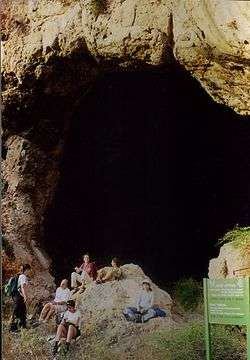Mugharet el-Zuttiyeh
Mugharet el-Zuttiyeh ("Cave of the Robbers")[1] is a prehistoric archaeological site in Upper Galilee, Israel.[2] It is situated 800 m (2,600 ft) from the Nahal Amud outlet, approximately 30 m (98 ft) above the wadi bed (148 m (486 ft) below sea level). It was found to house a fossil today known as the "Galilee skull" and "Galilee Man".[3]
Mugharet el-Zuttiyeh | |
 Entrance to Zuttiyeh Cave, Galilee | |
 | |
| Alternative name | Cave of the Robbers |
|---|---|
| Region | Upper Galilee, Israel |
| Coordinates | 32.855797°N 35.527210°E |
| Type | limestone cave |
| History | |
| Cultures | Acheulo-Yabrudian complex |
| Associated with | Homo heidelbergensis |
| Site notes | |
| Archaeologists | Francis Turville-Petre |
Discovered in 1925, the skull was the first fossilised archaic human found in Western Asia.[4] Together with the remains found at Es Skhul and the Wadi el-Mughara Caves, this find was classified in 1939 by Arthur Keith and Theodore D. McCown as Palaeoanthropus palestinensis.[5] Today its taxonomy is that of Homo heidelbergensis.[6][7]
Cave
Zuttiyeh cave is at the opening of a limestone ravine where Nahal Amud turns eastward, 250 m (820 ft) above a smaller cave known as Mugharet el-Emireh (Cave of the Princess).[8]
Galilee skull

The cave was excavated from 1925 to 1926 by Francis Turville-Petre.[6] It was the first paleontological excavation in the region.[10] Turville-Petre discovered a skull, referred to as the Galilee Skull, that was initially described as the second Neanderthal-like specimen. It was originally attributed to a Mousterian stratum and is now thought to be from an earlier Acheulo-Yabrudian complex. Later studies showed that the face was relatively flat, with no evidence of Neanderthal-like facial prognathism.[6]
The frontal bone and part of the upper face were found in the Mugharan level, which leads to an estimate of the age of the fossil to range from 200 to 500 kya. [11] Similarities with Zhoukoudian remains suggest a possible ancestral relationship.[12]
The Galilee skull, along with many of Turville-Petre's findings, is housed in the Rockefeller Museum in East Jerusalem.[3][4] A cast of the skull is on display at the Israel Museum.[9]
See also
- Archaeology of Israel
- List of human evolution fossils
- Qesem Cave
- Skhul and Qafzeh hominids
References
- "A comprehensive morphometric analysis of the frontal and zygomatic bone of the Zuttiyeh fossil from Israel" (PDF). Retrieved 2013-04-25.
- Human Evolution (2011-12-17). "The Zuttiyeh specimen from Israel, Galilee Skull". Pfpuech.newsvine.com. Retrieved 2013-04-25.
- Rast, Walter E. (1992). Through the Ages in Palestinian Archaeology: An Introductory Handbook. Continuum International Publishing Group. p. 50. ISBN 9781563380556. "Galilee man" (lowercase "m") in this source is a typo – ref. Solo Man, Peking Man and so forth.
- Cohen, Getzel M.; Joukowsky, Martha (2004). Breaking Ground: Pioneering Women Archaeologists. University of Michigan Press. Retrieved 2013-04-25.
- The stone age of Mount Carmel : report of the Joint Expedition of the British School of Archaeology in Jerusalem and the American School of Prehistoric Research, 1929–1934, p. 18
- Cartmill, Matt; Smith, Fred H. (2009). The Human Lineage. John Wiley & Sons. p. 320. ISBN 0471214914. Retrieved 2013-03-01.
- Pettitt, Paul (2013). The Palaeolithic Origins of Human Burial. Routledge. p. 59.Rabett, Ryan J. (2012). Human Adaptation in the Asian Palaeolithic: Hominin Dispersal and Behaviour during the Late Quaternary. Cambridge University Press. p. 90.
- Garrod, D. E. A. (1955). "The Mugharet el-Emireh in Lower Galilee: Type-Station of the Emiran Industry". Journal of the Royal Anthropological Institute of Great Britain and Ireland. 85 (1/2): 141–162. JSTOR 2844188.
- "The Israel Museum Permanent Exhibitions: Archaeology Wing – The Dawn of Civilization". New York: The Ridgefield Foundation. 1995. Skull (cast) Zuttiyeh Cave Lower Palaeolithic. Retrieved 2013-03-13.
- "Excavations in Wadi Amud". Persee.fr. Retrieved 2013-04-25.
- http://pages.nycep.org/ed/download/pdf/NMG%2043.pdf
- "Zuttiyeh face: A view from the East" (PDF). 91. National Center for Biotechnology Information. 2013-03-25: 325–47. doi:10.1002/ajpa.1330910307. PMID 8333489. Cite journal requires
|journal=(help)
Further reading
| Wikimedia Commons has media related to Zuttiyeh cave. |
- Lahr, Marta Mirazón (1996). The evolution of modern human diversity: a study of cranial variation. Cambridge University Press. ISBN 0-521-47393-4.
- Delson, Eric; Tattersall, Ian; Van Couvering, John A. (2000). Encyclopedia of human evolution and prehistory. Taylor & Francis. ISBN 0-203-00942-8.
External links
- What does it mean to be human?
- On the Animal Remains Obtained from the Mugharet-el-Zuttiyeh in 1925 & 1926 at Google Books